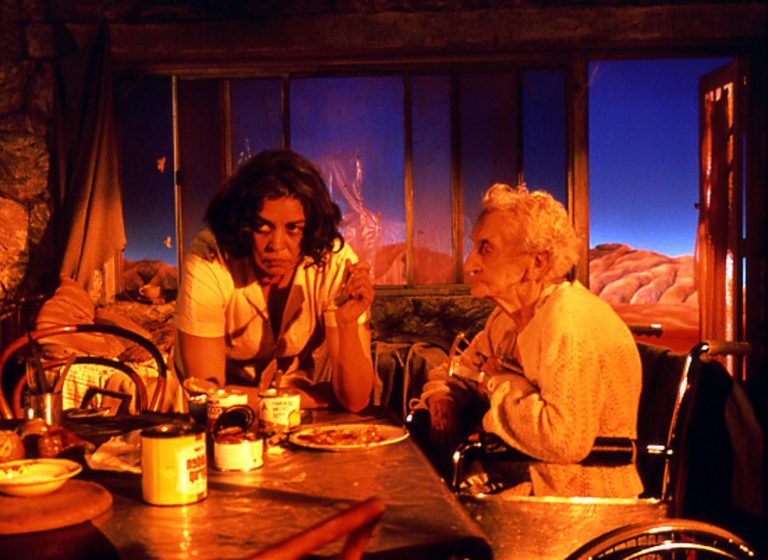We acknowledge the Traditional Owners of the land on which the Queensland Art Gallery | Gallery of Modern Art stands and recognise the creative contribution First Australians make to the art and culture of this country.

Tracey Moffatt / Australia/United States b.1960 / Night cries: A rural tragedy 1989 / 35mm film and Digital Betacam formats: 17 minutes, colour, sound / Purchased 2004 / Collection: Queensland Art Gallery / © the artist
Tracey MoffattNight cries: A rural tragedy 1989
Not Currently on Display
Night cries: A rural tragedy 1989 is layered with Indigenous cultural references and icons. The tense relationship between a white mother and her adopted Aboriginal daughter is a direct reference to Jedda, the first major colour film made in Australia in 1955.
Set against the unrelenting presence of the desert landscape, Moffatt’s film traps the pair together in this panorama and, in a sense, within Australia’s colonial history. Her colour palette alludes to the watercolour landscapes of Albert Namatjira (1902–59), a popular artist who was seen as a ‘traditional’ Aboriginal successfully working in a western medium. Through the faith of Aboriginal singer Jimmy Little, Moffatt also acknowledges the influence of Christianity on Indigenous families. Little and Namatjira are both popular cultural icons for all Australians.
Other references feel more personal: the compelling seaside shot of the daughter as a young woman — played by Aboriginal academic and activist Marcia Langton — could possibly refer to Moffatt herself, garlanded with dark wet seaweed that looks like film stock. Langton embodies the pain pervading the setting, yet she also resolutely copes with her difficult situation in the hope of some form of spiritual redemption.
Night cries was entered in the Cannes Film Festival of 1990 and exhibited at the Dia Center for the Arts in New York in 1997/98.
Tracey Moffatt was born in 1960 and grew up in Brisbane. After graduating from the Queensland College of Art, where she studied film and video production, she moved to Sydney in 1983 and worked as an independent filmmaker and photographer. As artist in residence at the Albury Regional Art Centre in 1989, she produced her critically acclaimed ‘Something more’ series.
Moffatt gained critical acclaim for her short film Night cries: A rural tragedy, which competed in the Cannes Film Festival in 1990. Moffatt’s work has been shown in solo exhibitions, including QAGOMA’s ‘Tracey Moffatt: Spirited’ in 2014, which showcased the ‘Night spirits’ series, and major group exhibitions such as the São Paulo Biennial and the Venice Biennale in 1997, and the Sydney Biennale in 1992, 1996 and 2000.
Moffatt refuses to be categorised as an ‘Aboriginal’ artist, finding the term stereotypical and politicised. However, several of her works have been concerned with issues especially affecting Indigenous Australians such as poverty, displacement and racism. She represented Australia at the 57th Venice Biennale in 2017.
Endnotes:
1Ewington, Julie. ‘Tracey Moffatt: Plantation’, in ‘The 6th Asia Pacific Triennial of Contemporary Art’. Queensland Art Gallery, Brisbane, 2009, p.140, col. ills p.26 (stills).